
Buy USA – Support the U.S. Breeders of High Quality Sporthorses A Perspective on Young Horses with Lisa Lourie of Spy Coast Farm
Blog
Buy USA – Support the U.S. Breeders of High Quality Sporthorses A Perspective on Young Horses with Lisa Lourie of Spy Coast Farm
Starting a young horse in any discipline takes time. It’s not the right fit for every rider, as the green prospect needs a good education from an experienced trainer. And just like you wouldn’t send an eighth grade student to a kindergarten teacher, young horses flourish best under a ‘teacher’ who specializes in bringing them along.
Lisa Lourie of Spy Coast Farm, located in Lexington, KY and Wellington, FL, began breeding sporthorses because she wanted quality progeny to evolve in this country and not simply retire. As she got more involved in the sport through her daughter’s competitive years, beginning in 2000, her interest in breeding grew. By 2008 her daughter was in the Junior Jumper division, trained by Shane Sweetnam.
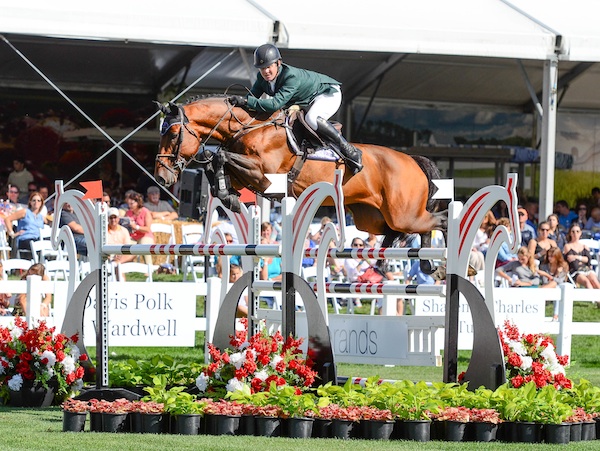
Shane Sweetnam aboard Chaqui Z won the 2014 New Albany Classic. Photo Credit: Kate Morrison photo
Lourie explained, “I was sponsoring Shane Sweetnam (her trainer) by then, so I would only buy him stallions or mares that had breeding potential.”
I interviewed Lisa Lourie about her perspective on the direction for Spy Coast Farm and the young horse market in the U.S.
JM: What have you learned as well as achieved since Spy Coast began?
LL: Probably the biggest thing I learned was that while it is relatively easy to breed a foal here in America, it is difficult to train it and bring it to market. The infrastructure simply does not exist to properly develop young sporthorses economically in this country. Spy Coast Farm is committed to helping develop that infrastructure. We are networking with many others across the country to develop a framework to develop a young horse pipeline for breeding AND the development young horses here in America. We are trying to build a fair and robust industry.
I believe Spy Coast has managed to draw the attention and the respect of some of America’s and Europe’s top riders and horse owners. These folks know that we are trying to help and grow the industry and they are committing their equine resources to the cause now as well. This is super exciting!
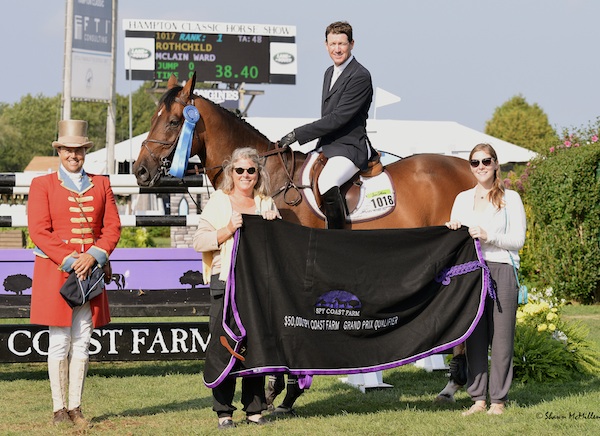
McLain Ward and Rothchild won the 2013 $50,000 Spy Coast Farm Grand Prix Qualifier at the Hampton Classic. Photo Credit: (c)Shawn McMillen
JM: What is your vision for Spy Coast Farm?
LL: I envision Spy Coast doing more training of young horses. I used to think it would be just breeding, but the demand for good quality, classical training is there.
JM: And what do you envision for the future of Spy Coast and the Young Horse market in the US?
LL: Every year we get more riders and owners breeding their top quality mares to our stallions. Many leave their foals with us for socializing and training. The rising costs of horses in Europe and perhaps more importantly, the lack of access to good horses there has led Americans to breed their own good horses here. That is good news for us as Americans. This is our best shot in a long time to develop a great breeding program here in the US.
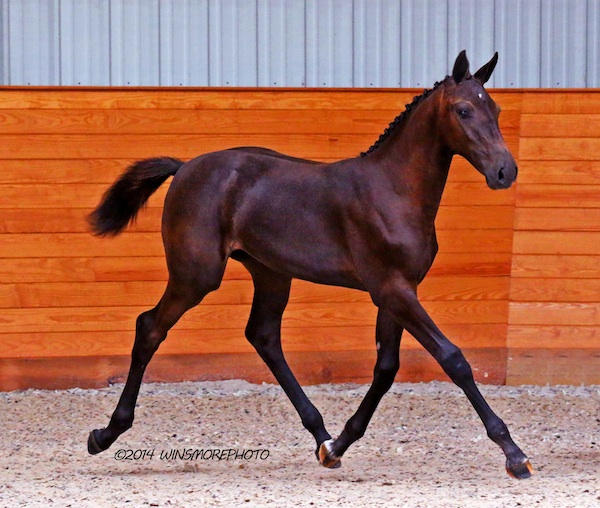
Olivia, the filly is BWP (Belgian Warmblood) Photo Credit: @2014 Winsmorephoto
JM: So have your goals changed?
LL: Yes my goals have gone more national. Where once I was content to just run my own breeding program, now I am more involved with USEF and USHJA and see the need to improve the breeding and training end of the equine industry.
JM: So how many breedings does Spy Coast handle per season?
LL: I breed approximately 20-24 foals of my own per season.
JM: How many foals are SCF owned vs foals you handle for others?
LL: We board between 6-8 foals for others on any given year. The number of young horses we train for others varies.
JM: When a young horse is ready to show – where do you go?
LL: Locally we go to shows at the Kentucky Horse Park, Derek Braun has schooling shows at his Split Rock Farm nearby, and we have our own Young Horse Shows, plus we take them to local parks, so a variety of venues. We can also now take young horses to Tryon, NC, only about five hours away. And we have taken some prospects to Florida for the Winter Equestrian Festival (WEF).
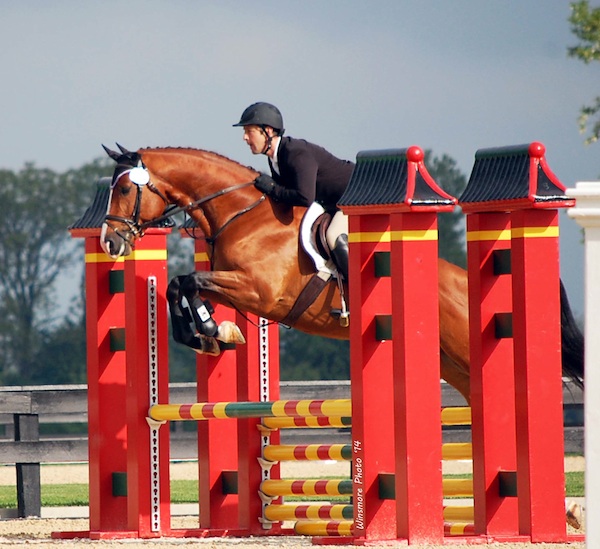
Kimmel SCF - Amaretto D'Arco x Rolette Lester. Photo Credit: @2014 Winsmorephoto
JM: Your feeling on the opportunities in Europe vs. U.S.
LL: Well, obviously the current opportunities are better established in Europe, but that can be both good and bad. An entrenched system can work against you as well as for you. We have the opportunity here in this country to craft a system that works best for us, with our unique needs, here in the U.S.. That is our challenge, to develop a system that addresses our vast geographic needs, in the infantile stages of our industry in a more modern technologic age. It is a challenge but also a great opportunity.
JM: So what is your approach to evolving the system in the U.S.?
LL: I am networking with the best in the business to ferret out who has the industry’s best interests at heart. I am not interested in working with people who are in it for their ego or for only money. Of course one has to make a profit, otherwise you can’t make a go of it, but transparency, honesty, integrity, those are the qualities I want to see in the people I work with. I want to work with these folks to create a system that will eventually benefit everyone who utilizes this industry, whether it is the first time horse buyer or the long time trainer. We need to clean up the system and have an all-for-one attitude to make it work, otherwise the industry will die on the vine.
On a more practical note, I am working directly with USEF, USHJA, top show managers, YJC, course designers and others to address young jumper show issues. Among other things, we are looking at cost, class structure and course design to make sure these classes are conducive to the proper training of young horses. This is a difficult process as opinions vary widely regionally and by time of year.
JM: And what about the training of young horses?
LL: I truly believe we are finally at a point where it can be as economical to breed and train a horse here in the U.S. as it is to do so in Europe. The problem is in finding a trainer who can provide the same learning opportunities as they can in Europe. This is the area that we need to focus on and develop. Not only to train these trainers to work with young horses and provide more economical young horse show opportunities, but help market this type of trainer to the public so they know they exist.
JM: You are not only thinking about the young horses, you are envisioning the sport as a whole. Can you explain this?
LL: My program was started because I just couldn’t believe that the equine talent I saw in the High Junior Jumper ring was going to be “put out to pasture” when their careers were over. Americans have been investing in some of the best horses in the world for a few decades, just as the Saudi’s are now. The Saudi’s have every intention of breeding those animals. Why aren’t we? We must if we expect to continue to compete on the world stage because otherwise we will not be able to afford access to Olympic level competitors.
We absolutely need to breed our own. We have all the resources to do so, we just need to organize the method to breed, train and provide show opportunities for them.
I implore our top-level athletes to put their mares and stallions back into the U.S. breeding system, to make them accessible to quality breeders who can bring their progeny to market. We all need to do our part to create the young horse pipeline. Plus young riders need to know how to properly train young horses, not just ride made mounts, because that is the future. This is a crucial gap we need to fill. If everyone plays his or her part, we can make this a viable market in the United States.
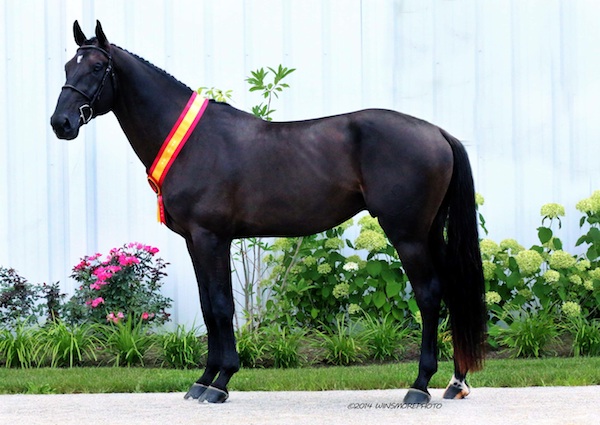
Labatt Bleu SCF - Amaretto D'Arco x Claudy Bay Z_Cumano. Photo Credit: @2014 Winsmorephoto
